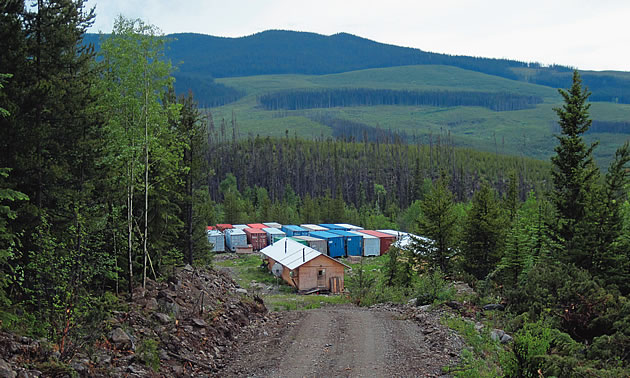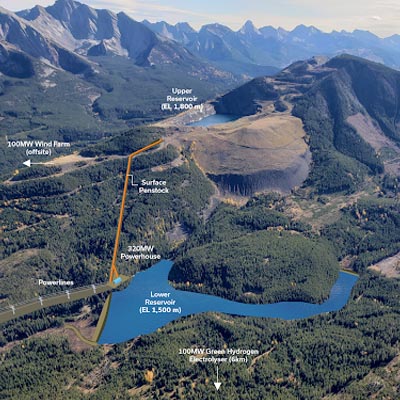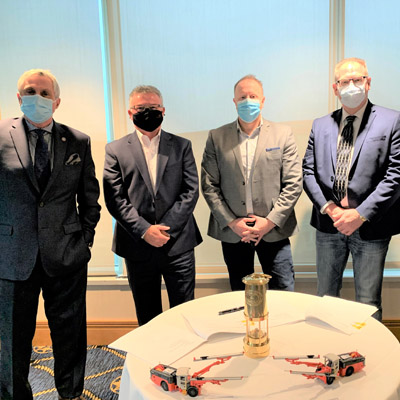Maintaining a positive outlook
Vancouver-based TTM Resources Inc. hopes to develop a British Columbia molybdenum deposit into a profitable mine

Drill core processing facilities are located on site at TTM Resources Inc.'s Chu Molybdenum Project. — Photo courtesy TTM Resources Inc.
Wes Raven is hopeful that someday his company can establish a prominent molybdenum mine in central British Columbia.
Raven, the vice-president of exploration for Vancouver-based TTM Resources Inc., is thinking about his company's wholly owned Chu project, located about 85 kilometres southwest of Vanderhoof, B.C., and only 75 kilometres southeast of the operating Endako molybdenum mine.
The ups and downs
TTM acquired the Chu project in 2006, when prices for molybdenum were on the rise. In fact, just before the financial crash in 2008, molybdenum was priced at $35 to $40 a pound, Raven said during a recent interview.
But shortly after the crash, molybdenum prices dropped to $8 a pound—and enthusiasm, and money, for mine development dried up.
Also, although molybdenum prices are now hovering around $14 to $15 a pound, TTM Resources Inc. remains in the midst of a provincial and federal government environmental review process and could use a little extra money to help it complete some necessary on-site work.
Yet Raven continues to remain positive about Chu's future.
"We are a major project," he said. "It is one of the largest stand-alone molybdenum projects in B.C., for sure. And we do have some copper, which we are working on to try and come up with a pretty good copper concentrate as well, because that would be sort of a value-added component for us."
In fact, a report completed for TTM in July 2010 shows a measured, plus indicated, resource totalling 370,640,000 tonnes at Chu, at a molybdenum cutoff rate at 0.04 per cent. That would translate into 482.2 million pounds of molybdenum and 286 million pounds of copper.
The same report calculates an inferred resource totalling 256,560,000 tonnes, also at a molybdenum cutoff rate at 0.04 per cent. That would translate into 294.2 million pounds of molybdenum and 203.7 million pounds of copper.
Meeting the requirements
The current timetable for development at Chu involves completion of an updated preliminary economic assessment report, perhaps as early as the end of this year. That would be followed by completion of a pre-feasibility study possibly a year after that.
But Raven said TTM must also complete at least two studies that are key components in the environmental review process. The company must gain environmental review approval before it can apply for a Mines Act permit.
The first study involves groundwater movement regarding a proposed Chu mine. The company must come up with an effective strategy to deal with water flowing into the mine's pit and with general surface run-off.
The second study involves potential acid-rock drainage at a proposed mine and what the company is planning to do to prevent possible environmental damage.
"You tend to want to stockpile lower-grade material here and there," Raven said, “and if that generates acid, you have to be aware of that and figure out a mitigating strategy to internalize that.”
The company also needs to do more pit engineering work to determine how technically solid or sound the surrounding rock is.
Not far to go
One advantage the Chu project has is that its mineralized body is fairly close to the surface. It is also about 1.7 kilometres long, close to 500 metres wide and has mineralization down to over 800 metres.
And if TTM does develop a mine, it's considering processing 120,000 tonnes of ore per day—that would mean a mine with a 20-year lifespan.
As for when the company might open a mine, Raven had this to say.
"It's years away," he said. "Realistically, it would be 2015 to 2017 before you'd see anything happen out there. I mean, there would be a two-year construction phase before you got down to actual production."
However, Raven is bullish on the mine's development, especially if the price of molybdenum rises. The project is price-dependent.
"We'd definitely like to see an increase in price," Raven said. "And a lot of that price increase is because you have to borrow $1 billion or more to get these things started. So you want to have a good price once you open up so you have an opportunity to pay that debt back quickly. And then after that, you can survive much lower prices—once you've kind of got your operation paid for."
Raven said molybdenum is used to make very high-strength, high-temperature steel and is also in big demand for pipeline steel because it's particularly resistant to corrosion. A TTM mine at Chu would include a mill on site that would produce a molybdenum concentrate; the concentrate would likely be transported by truck to Prince Rupert for shipment to smelters overseas in possibly India, China or South Korea.
If the Chu property were developed, approximately two semi-truckloads of concentrate would leave the mine per day.




